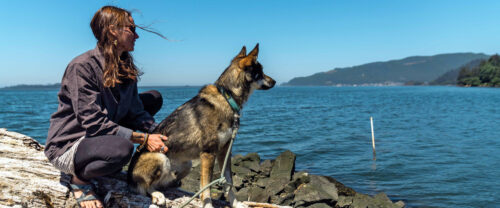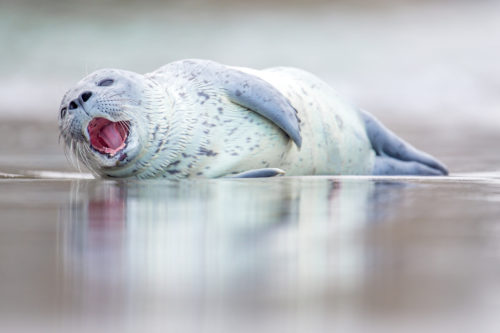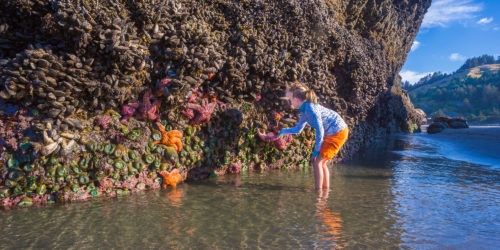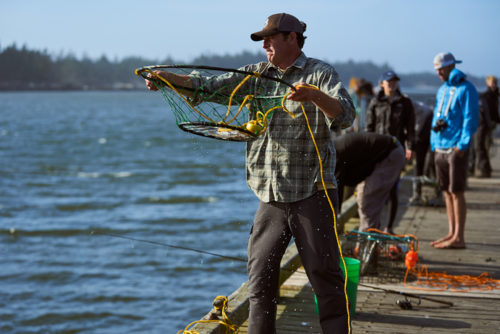COAST LIKE A LOCAL THIS WINTER: KNOW BEFORE YOU GO
Coast Like a Local
Oregon Coast Locals are the small business owners, surfers, fishers, farmers, and environmental stewards who call the coast home, 365 days a year. These tips will help you think and act like a local when you visit the coast. The easiest way to start? Respect people and nature by doing your research, and always know before you go.
Explore the tips below to find out how you can coast like a local!

There’s nothing better than a road trip to the coast. Locals know that the coast is remote, and easily affected by natural events like bad weather, landslides, and even snow coming over the mountain passes, so we like to be well-prepared for any trip:
- We know our route! Cell service can be spotty on the coast, so have a plan of where you’re headed, and know where emergency services are located.
- Before embarking on any coastal adventure, we visit Tripcheck.com for the latest info on road regulations, conditions and traveling guidelines.
- Our Oregon Pacific Coast Scenic Byway is an incredible drive– but only if everyone respects the rules of the road.
- We always give cyclists a little extra love, and a little extra room.
- On the coast wildlife is all around us, and sometimes deer and elk make their way onto the roadways. We drive carefully and give them plenty of space for their safety and ours.
Travel Resources
In peak season, we know our roads and parking lots are going to be crowded. No one likes to sit in traffic, and there’s a few ways you can help keep things moving smoothly:
- Arrive early, visit off-season, or check out less popular sites to avoid long waits at parking areas.
- Remember that parking along Highway 101, or in areas not designated for parking, can result in a ticket or fine.
- Know where you’ll need to pay: some parking lots charge parking fees to fund ongoing work. Research day-use fees and permits before you go!
- We’re conscious of our environmental impact when we drive, too. We carpool when we can, and know there’s always carfree transit options, such as buses or biking.
Driving & Parking Resources

Locals know that the Oregon Coast isn’t like other beaches – it’s unpredictable, and can be dangerous. Even on relatively calm days, ocean patterns, waves and currents can quickly change, so it’s important to stay alert while experiencing the coast.
- Know before you go! Check weather patterns, tide schedules, and fire restrictions.
- Sign up for emergency alerts from OR-Alert.
- Exercise common sense and caution during stormy weather, and to consider staying home on more risky, stormy days.
- A good rule that locals like to follow: Never turn your back to the ocean. Sneaker waves are real! These forceful waves are sudden (it’s right there in the name) and are known for carrying anything in their path out to sea.
- Don’t swim alone! Look out for signs of rip currents, which can be unpredictable and powerful. It’s also helpful to know the tidal predictions for that day.
- Take the time to carefully navigate rough and slippery coastal terrain, and refrain from climbing on driftwood logs, rocks and jetties.
- Avoid standing close to the edge or below cliffs, as coastal cliffs are susceptible to erosion and large portions of earth or rocks could crumble.
Resources
Check weather patterns, tide schedules and fire restrictions before exploring the coast. More safety tips, advice and resources can be found at Oregon State Park’s Beach Exploration Page.
King Tides happen throughout the winter. These highest tides of the year bring bigger swells and even more unpredictability. Know before you go by checking King Tide dates, and always using caution when traveling near beaches.
As Oregon Coast locals, we always need to prepared the possibility of tsunamis— this information is vital for visitors as well! It’s always best to expect the unexpected, and plan accordingly.
Know your evacuation routes: When visiting the coast, familiarize yourself with local tsunami evacuation routes. Maps are often posted in coastal areas or can be found online. Access detailed maps for your area at Oregon.gov.
Thinking of a beach fire? Do it the local way. Beach fires are usually allowed unless fire season or local rules say otherwise—so always check first. Use only small pieces of wood (big logs are prohibited), and keep your fire west of the vegetation line—no exceptions. That means away from beach grass and driftwood piles too. When you’re done, douse it with water until it’s cold to the touch. Don’t bury it—buried fires can smolder for hours and could cause someone to get burned.
It’s also crucial to check for current fire restrictions before starting a fire, as these can change quickly based on weather and fire danger.
Where are you staying? Check what kind of jurisdiction your campsite or beach falls under. You might be on State Parks land, or BLM. Check for site-specific alerts and fire restrictions at the links below:
Not sure where to start? Check the websites and Facebook pages of your town or county for local information on fires. You can also look at your county’s emergency management, sheriff’s office, or tribal police and follow them on social media for the latest updates.
Wildfires can and do happen on the coast! Checking for information about fire restriction, closures, air quality and emergency preparedness is critical for the safety of our visitors and residents.
Stay informed:
- Sign up for emergency alerts from OR-Alert.
- Understand Oregon’s 3-level evacuation system, so you’re prepared to leave if conditions get unsafe!
- For real-time wildfire updates, check InciWeb.
- Check AirNow to measure air quality before and during your trip.
- Use Tripcheck to check road conditions before you travel.
- For breaking news and information, follow the Twitter accounts and Facebook pages for Oregon State Parks, Oregon Department of Forestry, Oregon Department of Transportation, and Oregon Department of Emergency Management.

Walking our dogs on the beach might just be the top pastime for Oregon Coast locals. We’re excited for your pups to enjoy the coast too! Here’s a few tips to help you, and your pup, blend in with the locals:
- Leashes aren’t always required, but some beaches require you to leash up. Make sure you know before you go, and look for signage.
- Dogs that are off leash should reliably respond to voice commands. Owners must also always carry a leash and be ready and able to leash up their dogs if necessary. Dogs should be leashed within state parks, and in any area where wildlife reside to avoid disturbing the native creatures.
- We keep our pups away from wildlife, too:
- Dogs should never approach adult seals or seal pups, for the safety of both the dog and the seal.
- During Western Snowy Plover nesting season, spanning from March 15 to September 15, dogs are not permitted on designated plover beaches as they may inadvertently disturb the nesting birds.
- There are a few completely dog-free areas along the coast in protection of pets, coastal wildlife and visitors. These areas include: Nestucca Bay, Siletz Bay, and Bandon Marsh National Wildlife Refuges.
Resources
Dogs are welcome to join their owners on a trip to the Oregon Coast. Before em(bark)ing on a coastal visit, dog-in-tow, visitors may want to check out Oregon State Park “Pawsitive” info pages, which include answers to dog-related frequently asked questions.
Dog owners can also research Western Snowy Plover nesting cycles, and how those regulations could affect a coastal outing with their pet, at the Oregon State Park’s seasonal beach restriction page.

The coast is full of incredible ecosystems and wildlife. As locals, we are always learning to coexist with the nature around us – that means being aware of all the best ways to protect the mammals, birds, and even insects that contribute to this delicate ecosystem.
Here’s a few things to know before you visit:
- Marine mammals must be left alone. Please stay at least 50 yards away from seals and other marine mammals. Give them space and admire them from afar. A good rule of thumb: if an animal is reacting to your presence, you’re too close!
- We can all help protect the federally and state threatened Snowy Plover by knowing when and where they nest so we can be aware and walk only in permitted areas: below hide tide line and on hard-packed sand. In areas where signage is present, dogs (even on leashes), drones, vehicles, bikes, e-bikes, and kites are not allowed. avoid walking on dry sand, and pack out trash that could endanger them and other wildlife. Learn more here.
- We protect the threatened Oregon silverspot butterfly by staying on designated trails and refraining from picking flowers, especially in coastal meadow areas.
What else?
Packing out trash and leaving minimal impact where we travel is another critical piece of protecting all our wildlife. Learn more in the next section.
Locals know that the best way to protect and preserve the natural beauty and all life on the coast is to limit our impact – that means being mindful of what we take, and what we leave behind.
- We always pack out all trash and food scraps. Disposing of waste properly in designated bins mitigates the risk posed to wildlife and marine habitats.
- We all want to enjoy the natural beauty of the coast – but taking too many items like rocks, shells, and plants can harm the environment. It’s important to research specific guidelines and permits for each area to protect sensitive habitats and wildlife.
Resources
- The United States Department of Agriculture’s page on Special Forest Products contains helpful permitting information.
- The Oregon Department of Fish and Wildlife manages specific wildlife areas, such as the Marine Gardens, Research Reserves, Habitat Refuges, Marine Protected Areas and Marine Reserves, where debris collection is either restricted or not permitted. More information can be found on the Oregon Marine Reserves’ website.

The rocky shorelines of the Oregon Coast are unique – we love our sea stacks, islands, and tidepools as much as you do! But since we’ve spent a fair amount of time in these environments, we’ve picked up important things to know:
- Walking around the tidepools is allowed! But climbing up on sea stacks is prohibited. Large rocks and sea stacks are always closed for public use to protect nesting seabirds.
- This is important, because breaking this rule puts you at the risk of being stranded by the tide on an island, or being swept out to sea.
- When exploring tidepools, remember they are entire ecosystems that are beautiful but fragile. Touching them can affect the balance and cause harm over time.
- The same goes for stepping on these tiny worlds. Always try to watch your step and only walk on bare, dry rocks. Same goes for your pups!
- Remember to check tide times, know where you’re going and watch for sneaker waves when exploring these areas close to the sea.
Resources:
It’s always a great idea to check the regulations located on MyODFW.com before visiting the Oregon Coast, especially if you are planning to harvest any creatures during your visit.
Curious tide pool adventurers are invited to learn more about tide pool best practices, tide information, and facts on the captivating tide pools themselves. Start learning here!

Crabbing, clamming and fishing are some of our favorite coastal pastimes. Here are a few ways we keep ourselves and our marine environment safe when we venture out:
- We pay attention to the ocean and the weather: While clamming, crabbing or fishing, we always know that the ocean can be unpredictable and unsafe, especially during the stormy winter and fall months.
- We make sure we have all the correct permits and licenses, and know size/ catch limits.
- We check hotlines DAILY to make sure it’s safe to go clamming.
Resources:
Enthusiasts should conduct necessary research and outreach beforehand for information regarding permissible dates, size regulations and daily possession limits. Up-to-date regulations can be found at the Oregon Department of Fish and Wildlife’s page at MyODFW.com.
Crabbing and clamming can be dangerous if shellfish have been exposed to harmful toxins or contaminants. Check the shellfish safety hotline (800-448-2474) or visit the Oregon Department of Agriculture’s website before crabbing or clamming on the coast to ensure that there is not a toxin-related closure. The Oregon Department of Fish and Wildlife also has an accessible online guide for crabbing in Oregon.
Fishers are encouraged to check in with U.S. Fish and Wildlife Service frequently at 1-800-344-WILD, though their office is closed on federal holidays. Fishing guidelines can be accessed online at the U.S. Fish and Wildlife Service’s Fishing page.
Hunting is a great way for locals and visitors to experience Oregon’s natural setting and a sustainable way to procure food. As locals, there are a few things we do to make sure we can do so safely and responsibly:
- We make sure to know where hunting is permitted, and what type of hunting is allowed in each area.
- Regulations have been created around the habits and breeding cycles of the animals that are permitted for hunting. Hunting licenses also help purchase and set aside millions of acres for wildlife.
- We research licensing and seasonal hunting limits before embarking on any hunting trip.
Resources
There are a number of helpful resources for planning and mapping out a hunting trip in Oregon. Hunters can visit the Oregon Department of Fish and Wildlife’s website at MyODFW.com for information on what animals are permitted for hunting by season, and where hunting can take place. The U.S. Fish and Wildlife Service has information for waterfowl hunting areas, such as Bandon Marsh, Siletz Bay and Nestucca Bay. For those interested in hunting within a state park, information on general locations and park area rules can be found at statepark.org.
Nothing screams “tourist” quite as loudly as a drone that’s being launched or landed in a place it shouldn’t be. Drones are allowed on the coast (we use them, too!) but there are a few rules and regulations to know:
- It’s illegal to affect and harass wildlife with drones. Where allowed, drone operators are asked to launch their device at least 100 meters, equivalent to just over a typical city block, from any wildlife along the coast. Coastal regulations also forbid hunting or fishing with the help of drones.
- To help protect nesting seabirds, recreational use of unmanned aircraft is prohibited from Oregon Islands National Wildlife Refuge and on all refuge lands. Drones also shouldn’t take off from, land in or be operated from congressionally designated wilderness areas along the coast. These restrictions are in place to protect Oregon’s native species and because visitors seek these places for undisturbed solitude and quiet.
- Drones should always be flown according to Federal Aviation Administration regulations and privacy laws. For instance, drones should only be flown below 400 feet, remain clear of surrounding obstacles, stay at least 5 miles from an airport or backcountry airstrip, and steer clear of populated and noise-sensitive areas—such as campgrounds, trailheads and visitor centers.
- Practice common sense and safety to avoid damaging natural formations, such as Oregon’s sea stacks, and to steer clear of disturbing other visitors and coastal wildlife.
Resources
For more information on operating unmanned aerial systems throughout the country, visit the Federal Aviation Administration’s UAS page.
In addition, drone enthusiasts can reach out to Oregon State Parks for further information, questions or concerns regarding drone use on the Oregon Coast at 503-986-0707.

We want you to experience the true Oregon Coast – not only the beach, but the communities and the people that make this place so special. When you visit the coast, you’re making an impact on the people and nature that call this place home.
If you’re seeking an authentic coastal experience where you can give back and connect with the local community, consider these fantastic opportunities:
- Stay at Kind Traveler hotels, where a portion of every stay gives back to a local non-profit.
- Volunteer to build trails, restore habitats, and clean up beaches. Here are a few of our favorite partners who offer fun group volunteer opportunities all along the coast.
State Parks is raising its fees for the 2025/2026 season. Click here to learn more about this new fee structure, and make sure you are up-to-date on the latest permit requirements.
Explore
Coos Bay, OR
North Bend, OR
